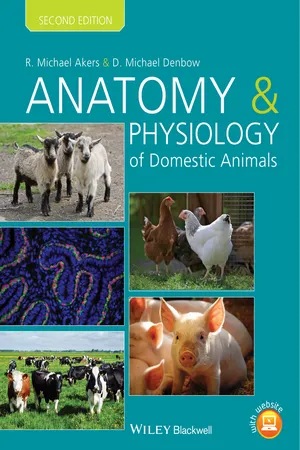
- English
- ePUB (mobile friendly)
- Available on iOS & Android
Anatomy and Physiology of Domestic Animals
About This Book
Anatomy and Physiology of Domestic Animals, Second Edition offers a detailed introduction to the foundations of anatomy and physiology in a wide range of domestic species. Well illustrated throughout, the book provides in-depth information on the guiding principles of this key area of study for animal science students, fostering a thorough understanding of the complex make-up of domestic animals. This Second Edition includes access to supplementary material online, including images and tables available for download in PowerPoint, a test bank of questions for instructors, and self-study questions for students at www.wiley.com/go/akers/anatomy.
Taking a logical systems-based approach, this new edition is fully updated and now provides more practical information, with descriptions of anatomic or physiological events in pets or domestic animals to demonstrate everyday applications. Offering greater depth of information than other books in this area, Anatomy and Physiology of Domestic Animals is an invaluable textbook for animal science students and professionals in this area.
Frequently asked questions
Information
Anatomy and physiology

Levels of organization
- Chemical level. Atoms are the smallest units of matter that have properties of an element. They combine with covalent bonds to form molecules such as molecular oxygen (O2), glucose (C6H12O6), or methane (CH4). The properties of various chemicals have a major influence on physiology. For example, at a low pH, a chemical may not be ionized and can thus cross a cellular membrane whereas above a certain pH, the same molecule may become ionized and thus unable to cross a lipid bilayer.
- Cellular level. As the smallest unit of life, cells have various sizes, shapes, and properties that allow them to carry out specialized functions. Some cells have cilium that allow them to move materials across their surfaces (i.e., the epithelial lining the bronchioles or cells lining the oviduct), whereas other cells are adapted to store lipids, produce collagen, or contract when stimulated.
- Tissue level. A tissue is a group of cells having a common structure and function. The four types of tissue include muscle, epithelia, nervous, and connective tissue.
- Organ level. Two or more tissues working for a given function form an organ. All four tissue types combine to form skin, the largest organ of the body, or the cochlea in the ear, the smallest organ of the body.
- Organ system level. Organs can work together for a common function. For example, the alimentary canal works with the liver, gallbladder, and pancreas to form part of the digestive system. The pancreas also functions as part of the endocrine system because of the pancreatic islets that produce insulin and glucagon. The organ systems include the integumentary, skeletal, muscular, nervous, endocrine, respiratory, digestive, lymphatic, urinary, and reproductive systems (Fig. 1.3).
- Organismal level. The organismal level, or the whole animal, includes all of the organ syste...
Table of contents
- Cover
- Title page
- Copyright page
- Preface
- Preface to the First Edition
- About the Companion Website
- 1: Introduction to anatomy and physiology
- 2: The cell: The common physiological denominator
- 3: Fundamental biochemical pathways and processes in cellular physiology
- 4: Tissue structure and organization
- 5: Integumentary system
- 6: Bones and skeletal system
- 7: Muscular tissue
- 8: Introduction to the nervous system
- 9: Central nervous system
- 10: Peripheral and autonomic nervous system
- 11: Special senses
- 12: Endocrine system
- 13: Cardiovascular system
- 14: Respiratory system
- 15: Immunity
- 16: Urinary system
- 17: Digestive system
- 18: Lactation
- 19: Reproduction
- Glossary
- Index